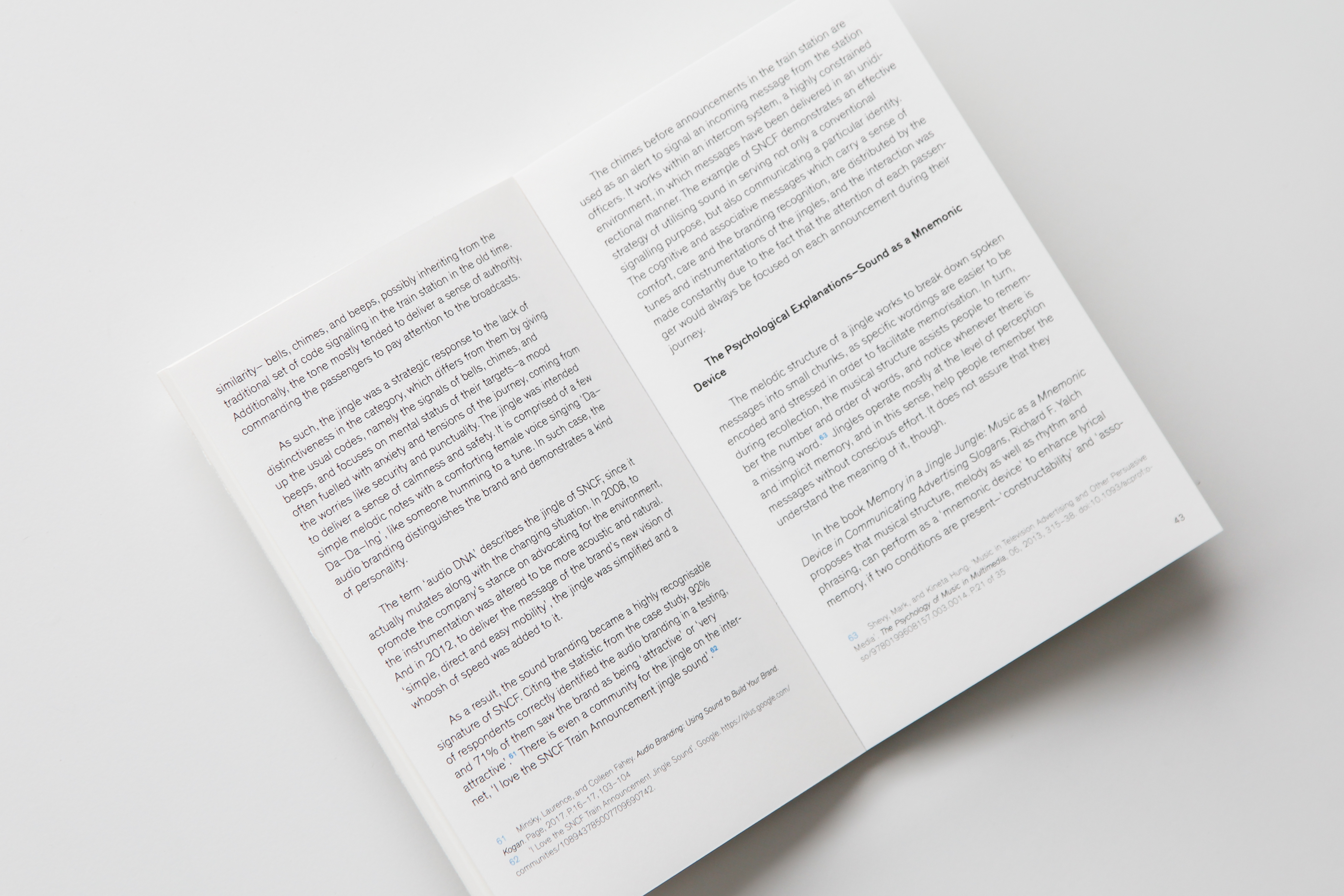

The thesis revolves from the politics of sound and its affirmative qualities to the masses; how could it summon a community, and formulate a sense of solidarity? By the use of musical sound and non-musical sound, how could a community reject the others, to draw its political and physical territory? How does a nation-state employ sound to defend and how one use it to attack? Sometimes strong cultural sounds are appropriated by a modern nation, just to deliver a sense of futility–to resist is futile. Birds sing to make noise as a tool for marking territorial boundaries. Do we make noise to give the same statement?
Excerpts from the publication:
Sound predetermines and regulates part of our identitiescollectively in the sense of exclusion. Sound is potentially an exclusion tool employed by a nation. With its invention and advertisement of its own myths, traditions, symbols, history and traits, nations attempt to include (integrate) all the differences. With the assistance of sound, as language, as songs, as culture, as sonic ritual and even as weapon, nations create social bonds between the people in the national community by excluding those who are not integrated into the collective resonance. In other words, it creates a demarcation of who is and who isn't the member of the national community, just as the territorial control executed by mosquito alarm, the sound sends a message to determine who to reject.
Sonic Rejection to a Generation–Mosquito Alarm
A sonic invention named ‘Mosquito’ appeared in 2008. The naming of it was definitely not an implicit metaphor. It specifically describes how the hidden machine was invented to impact it’s targets, to expel them like unwanted insects.
The Mosquito, or the Sonic Teenager Deterrent, aims precisely at the younger generation. The Mosquito emits high-pitch frequen- cies at approximately 16,000 Hz, a range of frequency which is perceptible and at the same time uncomfortable mostly for teen- agers. It is widely used in shopping centres and pedestrian zones to discourage recipients, namely the youth, from loitering in those kinds of space.
As the sensitivity of hearing decreases with age, frequencies above 12,000 Hz are barely audible to people over 25 years of age. It is an invasive and exclusive tool to the one who is not wel- comed, unwanted, for the shopping mall that is the loitering teen- agers who are economically unprofitable to them; and for some that could be the one who cause a daily conflict.
Apart from the usage in shopping malls, there is consumable household version on the market. A man living in Royton, Greater Manchester installed the device nearby his house, and commented that ‘this device has been a miracle’ for him. According to the report from UK newspaper The Independent, the device was installed nearby his residential house to keep teenagers away, as the family claimed to be suffered from their misbehaviour for months such as ‘antisocial behaviour, vandalism, racist abuse’. Thus anyone who is able to hear their noise, whether they behave badly or not, is definitely not going to stay around their property, including little kids from their neighbourhood, reported by the news, who felt ‘physically sick’ when playing outside.
Excerpts from the publication:
Sound predetermines and regulates part of our identitiescollectively in the sense of exclusion. Sound is potentially an exclusion tool employed by a nation. With its invention and advertisement of its own myths, traditions, symbols, history and traits, nations attempt to include (integrate) all the differences. With the assistance of sound, as language, as songs, as culture, as sonic ritual and even as weapon, nations create social bonds between the people in the national community by excluding those who are not integrated into the collective resonance. In other words, it creates a demarcation of who is and who isn't the member of the national community, just as the territorial control executed by mosquito alarm, the sound sends a message to determine who to reject.
Sonic Rejection to a Generation–Mosquito Alarm
A sonic invention named ‘Mosquito’ appeared in 2008. The naming of it was definitely not an implicit metaphor. It specifically describes how the hidden machine was invented to impact it’s targets, to expel them like unwanted insects.
The Mosquito, or the Sonic Teenager Deterrent, aims precisely at the younger generation. The Mosquito emits high-pitch frequen- cies at approximately 16,000 Hz, a range of frequency which is perceptible and at the same time uncomfortable mostly for teen- agers. It is widely used in shopping centres and pedestrian zones to discourage recipients, namely the youth, from loitering in those kinds of space.
As the sensitivity of hearing decreases with age, frequencies above 12,000 Hz are barely audible to people over 25 years of age. It is an invasive and exclusive tool to the one who is not wel- comed, unwanted, for the shopping mall that is the loitering teen- agers who are economically unprofitable to them; and for some that could be the one who cause a daily conflict.
Apart from the usage in shopping malls, there is consumable household version on the market. A man living in Royton, Greater Manchester installed the device nearby his house, and commented that ‘this device has been a miracle’ for him. According to the report from UK newspaper The Independent, the device was installed nearby his residential house to keep teenagers away, as the family claimed to be suffered from their misbehaviour for months such as ‘antisocial behaviour, vandalism, racist abuse’. Thus anyone who is able to hear their noise, whether they behave badly or not, is definitely not going to stay around their property, including little kids from their neighbourhood, reported by the news, who felt ‘physically sick’ when playing outside.




Research & Text
Wai Lun HSU
Artist Wai Lun HSU
Supervised by Jasper Coppes
Layout & Typography Lai Ping So
Binding & Production mmmmor studio
Artist Wai Lun HSU
Supervised by Jasper Coppes
Layout & Typography Lai Ping So
Binding & Production mmmmor studio
